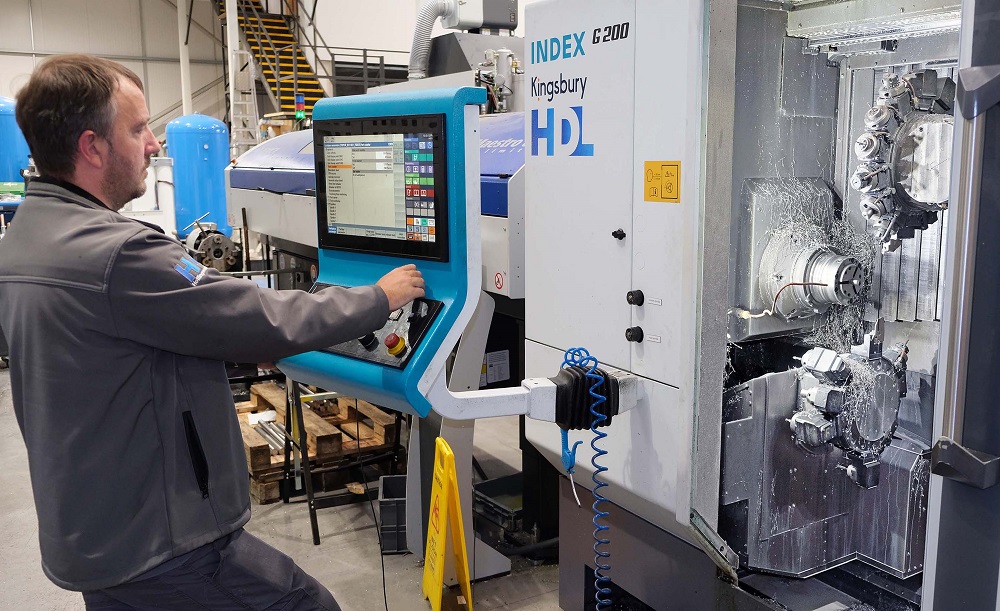Medical systems manufactured by Hollingworth Design Ltd (HDL) at its Stockport factory
now contain components milled and turned in-house, avoiding the unreliability and cost of
sourcing from subcontractors. Now, third parties only produce sheet metalwork. The first
CNC lathe and mill were installed in 2017, followed by another turning centre and a
German-built Index G200 twin-spindle, triple-turret, turn-mill centre supplied in 2020 by
sole agent Kingsbury.
Since then, the number of lathes and mills on-site has doubled to eight, including a smaller
capacity Index C100 and HDL’s first automated prismatic machining cell: a robot-fed, five-
axis, HSK-A63 spindle C12 from Hermle, Germany, also represented exclusively in the UK by
Kingsbury.
The same period has seen the arrival of a CNC mitring saw, an Aberlink co-ordinate
measuring machine, a Keyence optical inspection system and the company’s first quality
control inspector, Simon Tweedie. Other new members of staff are Richard Binks, who is
dedicated to subcontract sales, and Nick Mort, lead engineer in charge of the CNC section.
Mort says: “The subcontract side of our business has increased fivefold to 25% of turnover
in the past two years and we’re aiming to increase it to 50% by 2026.”
The 65 mm bar capacity Index G200, which is fitted with a 3 m bar magazine, is playing a
major role in fulfilling the growing number of contracts. The upper, double tool carrier has a
360° B axis and a ±65 mm Y axis. On one side is a 14-station, live tool turret rated at 16
kW/16 Nm (25% DC) and 7200 rpm maximum speed. On the other side is an HSK-A40 22
kW/52 Nm (25% DC) milling spindle with automatic cutter exchange, enabling considerable
machining versatility in combination with the two lower turrets that also serve the 6000
rpm/32 kW main and counter spindles.
Arranged in mirror image, each lower turret has an independent, ±45 mm Y axis and an
identical rating to the turret at the top. To optimise productivity, it is possible to utilise all
three turrets simultaneously at either the main or counter spindle, without interference.
Alternatively, simultaneous machining the front end of a component at the main spindle
and the reverse end at the counter spindle, in contrast to sequential machining on HDL’s
earlier lathes, has cut cycle times dramatically. To produce a typical turned, threaded and
engraved brass manifold component, for example, the typical cycle time is just 90 seconds
(down from 4 minutes), with similar gains evident when producing subcontract parts for
other OEMs.
Given the lathe’s high power and versatility, it is not surprising there was a tendency to
prioritise the use of this Index turn-mill centre when considering which machine to employ
for producing a new or existing part, even if it mostly entailed prismatic machining using the
driven tools. So another lathe from the same source, an Index C100 with 42 mm bar
capacity and a more conventional three-turret configuration, arrived to produce most of the
turn-milled components for internal use. As a result, the larger lathe is free to fulfil mainly
subcontract work, which is often more complex and generally larger.
Mort says: “We had no hesitation returning to Kingsbury for another Index lathe, as the first
proved very reliable and the back up from the agent was prompt, efficient and friendly.”
For that reason, in early 2023, when HDL wanted to acquire its first automated machining
centre, it selected Kingsbury again for the purchase of the Hermle cell. It was preceded by a
stand-alone, five-axis, 30-taper mill-turn machine from another supplier for producing
aluminium parts for a bicycle manufacturer in the north of England. The contract was
growing in variety and volume, especially with the introduction of an electric bike, so
automation was the obvious choice for producing the parts more cost effectively.
As the bicycle components are relatively light, it was decided that a Hermle RS05 robot for
handling individual billets into the machining area and returning finished parts was
preferable to automated pallet exchange. The latter would incur more cost to buy the
pallets and work-holding equipment and entailed extra work for fixturing and removing
parts.
Now, the 30-taper model and the Hermle share machining of the bicycle parts. The
production of prototypes takes place on the former, while larger batch work occurs on the
latter; 50-off, say, if piece-part cycle time is 15 to 20 minutes, or 200-off minimum in the
case of shorter cycles.
To support HDL while its engineers were familiarising themselves with operating the Hermle
cell and programming it with the help of a new seat of SolidWorks CADCAM software,
Kingsbury provided a suite of eight turnkey packages, each comprising a program, set-up
sheet and list of recommended tooling.
“These days, it’s difficult to find skilled setter-operators,” says Mort. “An automated cell like
the Hermle helps to mitigate the situation, as once it is set it just runs, including overnight,
producing parts to tolerances from ±0.25 mm right down to ±10 µm.”
In addition to the medical and bicycle manufacturing sectors, HDL regularly serves
motorsport, aerospace and the marine industry. It also supplies tight-tolerance, mainly
titanium parts that go into test equipment built by Hyderogen, a hydrogen technology
consultancy owned by Kris Hyde, who is joint managing director of HDL together with the
company founder, Paul Hollingworth.
For further information www.kingsburyuk.com















